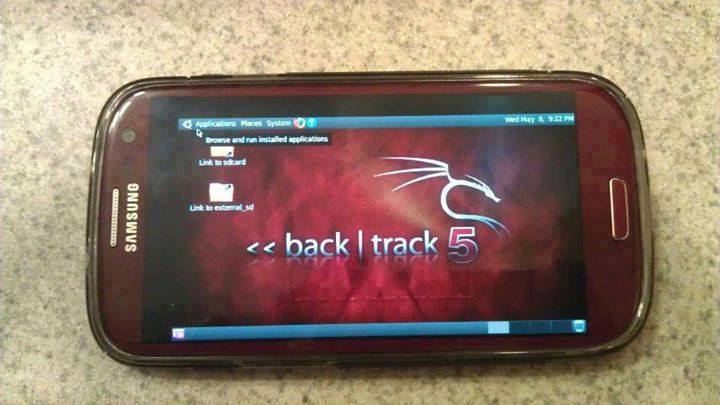How To Install And Run Backtrack On Android
Guide you step by step to How to install and run Backtrack on android. As the Backtrack is also available with ARM architecture which makes it possible to run Backtrack on an ARM machine such as mobiles or tablets.
Recently, We are discussed Install and Run BackTrack on Windows. Android is the best OS for penetration testing. It designed for digital forensics and penetration testing or hacking tool. It comes with many more updated tools. As the Backtrack is also available with ARM architecture which makes it possible to run Backtrack on an ARM machine such as mobiles or tablets.

How To Install and Run Backtrack On AndroidRequirements
- A Rooted Device [ Root Simple Android Phone Without Pc ]
- Backtrack ARM [ Download ]
- BusyBox [ Download ]
- Android Terminal and Android VNC
- If you are using PC then you need 7zip for extraction otherwise you can use zarchiver on your android phone. [ Download ]
Step to Install and Run Backtrack On Android:
First of all extract the BT5-GNOME-ARM.7z. and copy the "BT5" folder and then put in your phone's root directory. Here mine phone is /sdcard. The root directory is different for different mobile devices.
- Now install all the above apps Busybox, Android Terminal, Android Vnc.
- After installing BusyBox application open it and wait until it finishes loading and then click on Smart install.
- Now open the android terminal and type the following command:
su cd /sdcard/BT5sh bootbtNOTE :- When you type su in terminal it will ask you for superuser request and you have to tap on Grant. - After this, type the following commands in terminal.
export USER=rootvncpasswd - After entering vncpasswd the terminal will ask you to enter the password. Enter the desired password and hit enter.
- Now type the following commands.
tightvncserver -geometry 1280×720 - The terminal emulator will create the localhost to connect it to VNC server. Now note the localhost port marked red below. Now minimize the terminal emulator.
- Open the Android VNC and type the following settings.
Nickname : BT5
Password : your password here which you entered in terminal (step no.6)
Address : localhost
Port : 5906
Password : your password here which you entered in terminal (step no.6)
Address : localhost
Port : 5906
NOTE: Make sure that your localhost's port matches with terminal's localhost. Here mine New 'X' desktop is localhost:6. You may be different. So, in VNC type Port 590X where the "X" is the localhost in the android terminal.
That's it now just tap on connect to run the Backtrack on your android. So in this way you successfully install and run backtrack 5 on android. If you face any problem feel free to discuss in below comments!
Related news
- New Hack Tools
- Hacking Tools 2019
- Hacker Tools For Ios
- Hacker Tools For Windows
- Pentest Tools Online
- Hackrf Tools
- Nsa Hacker Tools
- Hack Tools
- Hacker Tools For Mac
- Hackrf Tools
- Easy Hack Tools
- Pentest Recon Tools
- Pentest Tools Download
- Hacker Tools Online
- Growth Hacker Tools
- Hacker
- Hacker
- Pentest Tools Find Subdomains
- Pentest Tools For Windows
- Hack App
- Hacker Tools Software
- Hacker Techniques Tools And Incident Handling
- Hacker Tools Hardware
- Top Pentest Tools
- Hack Tools Mac
- Easy Hack Tools
- Hacker Search Tools
- Hack Rom Tools
- Hacking Tools Usb
- Hack Tools For Mac
- Tools For Hacker
- Hacker Tools Free Download
- Pentest Tools Subdomain
- Best Hacking Tools 2020
- Hacker Techniques Tools And Incident Handling
- Nsa Hack Tools
- Hack And Tools
- Hacker Security Tools
- Pentest Tools Linux
- Bluetooth Hacking Tools Kali
- Hacker Hardware Tools
- Pentest Tools Alternative
- Hacker Tools Software
- Hack Tools For Games
- Game Hacking
- Pentest Tools Android
- Pentest Tools Bluekeep
- Best Hacking Tools 2020
- Hacker Tools Hardware
- Pentest Tools Download
- Hacking Tools Hardware
- Best Hacking Tools 2020
- Pentest Tools Apk
- Hak5 Tools
- Pentest Reporting Tools
- Hackers Toolbox
- Blackhat Hacker Tools
- Android Hack Tools Github
- Wifi Hacker Tools For Windows
- Bluetooth Hacking Tools Kali
- Hacker Tools Online
- Pentest Tools Free
- Hacking Tools For Mac
- Hacks And Tools
- Hacking Tools Software
- Hackers Toolbox
- Hacker Tools Windows
- Hacking Tools For Beginners
- Pentest Reporting Tools
- Pentest Tools For Windows
- Nsa Hacker Tools
- What Is Hacking Tools
- Hacking Tools Usb
- Nsa Hack Tools
- Pentest Automation Tools
- Underground Hacker Sites
- Hacker Tools Apk
- Hacking Tools For Windows 7
- Underground Hacker Sites
- Easy Hack Tools
- Pentest Tools Github
- Pentest Tools Android
- Pentest Tools Bluekeep
- Best Pentesting Tools 2018
- Hacker Techniques Tools And Incident Handling
- Hacking Tools Download
- Hacking Tools 2020
- Hacker Tools List
- Hacker Tool Kit
- Hacking Tools Github
- Free Pentest Tools For Windows
- Hacking Tools Pc
- Hacking Tools 2020
- Black Hat Hacker Tools
- Github Hacking Tools
- Pentest Tools Find Subdomains
- Hacking Tools Name
- What Are Hacking Tools
- Nsa Hack Tools
- Hacking Tools Name
- Hack Website Online Tool
- Hacker Tools Free Download
- Pentest Tools List
- Pentest Recon Tools
- Top Pentest Tools
- Ethical Hacker Tools
- Best Hacking Tools 2020
- Kik Hack Tools
- Hacking Tools Windows
- Hacker Tools 2019
- Hacking Tools Github
- How To Install Pentest Tools In Ubuntu
- Hack Tools Pc
- Hacker Tools Free
- Pentest Tools Framework
- Pentest Tools For Mac
- Hacking Tools For Kali Linux
- Hacker Tools Apk Download
- Hacking Tools Pc
- Hacker Tools Online
- What Are Hacking Tools
- Hacker Tools For Mac
- Usb Pentest Tools
- Hacking Tools Hardware
- Best Hacking Tools 2020
- Hacking Tools For Pc
- Pentest Tools Download
- New Hacker Tools
- Top Pentest Tools
- Pentest Tools Apk
- Hack And Tools
- What Are Hacking Tools
- Hack Tool Apk
- Hacking Tools For Games
- Pentest Tools Website
- Top Pentest Tools
- Tools 4 Hack
- Hacker Tools Mac
- Hacking Tools And Software
- Pentest Tools Linux
- Hacker Tools Free Download
- Hacking Tools Software
- Hacker Tools Software
- Hacker Techniques Tools And Incident Handling


